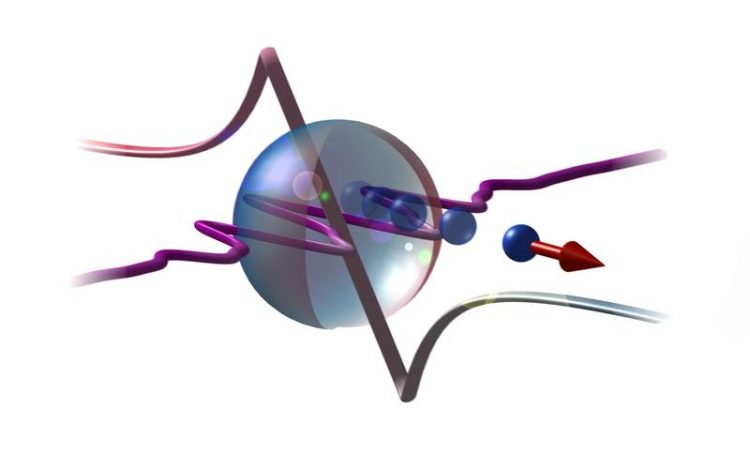Lightwave controlled nanoscale electron acceleration sets the pace

The waveform-controlled laser pulse creates a plasmon-enhanced near-field that drives the forward acceleration of an electron during its passage through the nanometer-sized metal cluster.
Of particular importance for potential applications is the ability to manipulate the acceleration process, known as a swing-by maneuver from space travel, with the light waveform. This could facilitate an all-optical generation of attosecond electron pulses.
When metal clusters, small nanoparticles consisting of just a few thousand atoms, are exposed to intense laser light, electrons inside the particle are excited to a swinging collective motion. The electron cloud’s motion, a plasmon, can be excited resonantly with light of a suitable color leading to very high amplitudes and an enhanced electric field inside the cluster.
In the experiment, which was conducted at the Institute of Physics in Rostock, a team of researches around Prof. Thomas Fennel has now deliberately exploited this enhanced near-field. With so-called two-color laser pulses the scientists tailored the plasmonic field via the waveform of the light field.
This led to a controlled slingshot-type acceleration of electrons traversing the nanoparticle within only one optical cycle. These experimental results, together with their interpretation by a theoretical model, were now published in the Journal Nature Communications.
In their study, the researchers demonstrated that electronic processes in clusters can be controlled with the waveform of laser light. The few nanometer-sized clusters serve as ideal experimental and theoretical model systems for investigating new physical effects in the light matter interaction of nanostructures. “In our experiment we could show that electrons can gain energies of up to one kiloelectron volt within just one optical cycle in the nanoaccelerator.
This corresponds to an enhancement of more than one order of magnitude with respect to the strong-field ionization of atoms.”, describes Dr. Josef Tiggesbäumker from the Institute of Physics in Rostock, who together with first author Dr. Johannes Passig from the team around cluster physicist Prof. Karl-Heinz Meiwes-Broer has developed the setup for the experiments.
„The acceleration of electrons via near-field-assisted forward scattering can be switched with attosecond precision (1 attosecond = 1 billionth of a billionth of a second) by tailoring the light waveform.“, adds Prof. Matthias Kling from the Ludwig-Maximilians-Universität Munich and the Max Planck Institute of Quantum Optics in Garching, who provided the technology for the generation of the phase-controlled laser pulses.
„The control with just and only the laser light paves new ways for the intensely researched area of light-based particle acceleration”, sums up Fennel from the University Rostock and the Max Born Institute in Berlin, who developed the concept for the study. The researchers plan to realize the acceleration principle in multiple stages in the future to investigate its potential applications in laser-driven grating accelerators.
Original publication:
Johannes Passig, Sergey Zherebtsov, Robert Irsig, Mathias Arbeiter, Christian Peltz, Sebastian Göde,Slawomir Skruszewicz, Karl-Heinz Meiwes-Broer, Josef Tiggesbäumker, Matthias F. Kling, Thomas Fennel
Nanoplasmonic electron acceleration by attosecond-controlled forward rescattering in silver clusters
Nature Communications 8, 1181 (2017), DOI: 10.1038/s41467-017-01286-w
http://dx.doi.org/10.1038/s41467-017-01286-w
For further information, please contact:
Prof. Dr. Thomas Fennel
Theoretical Cluster Physics and Nanophotonics
Institute of Physics, Rostock University
Albert-Einstein-Str. 23, 18059 Rostock, Germany
Phone: +49-381-498 6815, E-Mail: thomas.fennel@uni-rostock.de
and
Max Born Institute
Max-Born-Straße 2, 12489 Berlin, Germany
Phone: +49-030-6392 1245, E-Mail: fennel@mbi-berlin.de
Prof. Dr. Matthias Kling
Ultrafast Nanophotonics, Laboratory for Attosecond Physics
Department of Physics, Ludwig-Maximilians-Universität Munich &
Max Planck Institute of Quantum Optics
Hans-Kopfermann-Str. 1, 85748 Garching, Germany
Phone: +49-89-32905-234, E-Mail: matthias.kling@physik.uni-munechen.de
PD. Dr. Josef Tiggesbäumker
Clusters and Nanostructures
Institute of Physics, Rostock University
Albert-Einstein-Str. 23, 18059 Rostock, Germany
Phone: +49 381 498-6805, E-Mail: josef.tiggesbäumker@uni-rostock.de
Media Contact
More Information:
http://www.uni-rostock.deAll latest news from the category: Physics and Astronomy
This area deals with the fundamental laws and building blocks of nature and how they interact, the properties and the behavior of matter, and research into space and time and their structures.
innovations-report provides in-depth reports and articles on subjects such as astrophysics, laser technologies, nuclear, quantum, particle and solid-state physics, nanotechnologies, planetary research and findings (Mars, Venus) and developments related to the Hubble Telescope.
Newest articles

NASA: Mystery of life’s handedness deepens
The mystery of why life uses molecules with specific orientations has deepened with a NASA-funded discovery that RNA — a key molecule thought to have potentially held the instructions for…

What are the effects of historic lithium mining on water quality?
Study reveals low levels of common contaminants but high levels of other elements in waters associated with an abandoned lithium mine. Lithium ore and mining waste from a historic lithium…

Quantum-inspired design boosts efficiency of heat-to-electricity conversion
Rice engineers take unconventional route to improving thermophotovoltaic systems. Researchers at Rice University have found a new way to improve a key element of thermophotovoltaic (TPV) systems, which convert heat…



